Evolution of the NOAA Climate Program
NOAA's research laboratories, Climate Program Office, and research partners conduct a wide range of research into complex climate systems and how they work. These scientists work to improve their ability to predict climate variation in both the shorter term, like cold spells or periods of drought, and over longer terms like centuries and beyond.
- Introduction
- The NOAA Climate Program
- Climate Forecasts
- Carbon Dioxide & Climate
- A National Approach
- Conclusion
Weather is the day-to-day changes in the state of the atmosphere, while climate is the long-term average of weather. Since we see and feel the impacts of weather on a daily basis, we tend to pay closer attention to its changes. The same is true in terms of scientific research—we often start with what we can see and evolve research programs as our understanding grows. Scientists have been observing and forecasting weather patterns much longer than climate change.
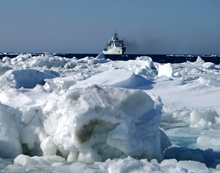
NOAA researchers have been traveling the world to collect data to help us better understand our planet’s climate.
In recent years, NOAA has made significant strides to close the gap between weather and climate research. This was accomplished through the development of NOAA programs, projects, and partnerships to address regional climate variability.
This article focuses on some of the more notable advancements in NOAA climate science and key transitional steps that NOAA has taken related to climate research since the 1980s and 1990s.
The NOAA Climate Program
As scientific understanding and the needs of our nation have evolved since the 1990s, so too has the focus of NOAA’s Climate Program.
A Climate Vision for the ’90s
NOAA established its Climate Program in the 1990s. At this time, the program focused on predicting and assessing environmental changes connected to climate over periods of decades to centuries. For example, NOAA looked at connections between climate change and greenhouse warming, ozone layer depletion, and air quality improvement.
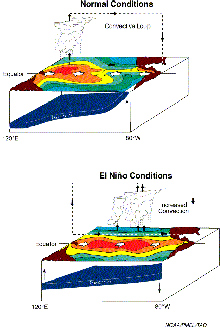
In normal, non-El Niño conditions (top panel), the trade winds blow towards the west across the tropical Pacific. During El Niño conditions (bottom panel), the winds pushing that water get weaker. Both of these tend to make the water in the eastern Pacific warmer, which is one of the hallmarks of an El Niño. Click image for larger view.
Another important goal of the program during the 1990s was to implement seasonal to interannual climate forecasts. NOAA envisioned working with academic and multinational partners to provide one-year lead-time forecasts for global climate variability, particularly with regard to El Niño and the resulting precipitation and surface temperature distributions. These forecasts were expected to increase society’s ability to mitigate economic losses and disruptions associated with El Niño events.
The Climate Vision of Today
NOAA’s Climate Program has evolved consistently over the years, from observing the environmental variables needed to describe the climate system to reducing uncertainty in global climate models and predictions. Building upon the knowledge and progress made during the 1990s, NOAA revisited its climate goals to reflect existing priorities and capabilities within the agency and broader scientific community. Today, NOAA is focusing climate science efforts on understanding and describing climate variability and change in order to enhance our ability to plan and respond to environmental changes tied to climate.
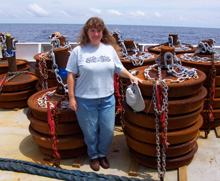
Programs such as NOAA’s Teacher at Sea Program provide opportunities for teachers to participate in NOAA research onboard survey ships, working under the tutelage of scientists and crew. Armed with new understanding and experience, teachers take this knowledge back to their classrooms. EPIC Teacher at Sea Jennifer Richards helped deploy a buoy while participating in an interactive teaching and learning experience aboard ship.
The Climate Program leads NOAA climate education and outreach activities, aimed at improving the environmental literacy of the public in terms of climate. All of NOAA’s long-term goals ultimately depend on the public’s capacity to understand and react to Earth system science and ecosystem conditions. A better-informed public will provide improved environmental stewardship and will acquire, use, and respond to NOAA’s information services and forecasts in more effective ways. Given the central role of environmental literacy to NOAA’s long-term effectiveness, NOAA places a high priority on formal and informal education.
The Climate Program also coordinates international climate activities. International observations, analysis, and data stewardship are critical for describing and understanding the state of the climate. Only with international collaboration and feedback will it be possible to reduce uncertainty in climate projections or improve predictive capability. Also, global outreach and partnerships are necessary to ensure the relevance and effective application of our climate products and services.
Participation in multilateral and bilateral policy discussions is also an important part of NOAA's climate work. NOAA interacts with the Global Earth Observing System of Systems (GEOSS), the United Nations Framework Convention on Climate Change, the Intergovernmental Panel on Climate Change, the World Meteorological Organization, key bilateral partners, and other climate leadership organizations. Through these interactions, NOAA provides worldwide access to its state-of-the-art climate research, tools, and products and draws information that can help to improve its responsiveness to pressing needs for climate information and services.
Over the years, NOAA has achieved a number of scientific advancements with both national and international importance. For example, seasonal to interannual climate forecasts at NOAA have evolved to predict El Niño events with enough accuracy and lead-time to save hundreds of millions of dollars around the world. NOAA has also placed considerable emphasis on global issues, such as long-term climate change.
Seasonal to Interannual Climate Forecasts
NOAA’s seasonal to interannual climate forecasting capabilities date back to the Tropical Ocean-Global Atmosphere research program (TOGA), initiated in 1984. This 10-year program was designed to provide an understanding of the role of the tropical Pacific Ocean in determining climate changes over North America, with a principal focus on the El Niño Southern Oscillation (ENSO).
The larger TOGA program has evolved since 1994 into the Climate Variability and Predictability (CLIVAR) program. CLIVAR is an international, interdisciplinary research effort within the World Climate Research Program focused on seasonal, decadal, and centennial forecasting. CLIVAR scientists are also interested in gaining a greater understanding of human influences on climate change.
The TAO-TRITON Array
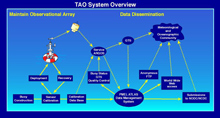
The TAO/TRITON Array studies year-to-year climate variations related to El Niño and consists of 70 buoys in the Pacific Ocean. Scientists use data from the TAO to identify causes of El Niño. Click image for larger view.
A hallmark of the TOGA program was the ENSO observing system, now known as the TAO-TRITON array. Deployed between 1985 and 1994, this network of about 70 moorings in the tropical Pacific consists of NOAA’s Tropic Atmosphere-Ocean (TAO) array and Japan’s Triangle Trans-Ocean Buoy Network (TRITON). The TAO Array measures oceanographic and surface meteorological variables critical for improved detection, understanding and prediction of seasonal-to-interannual climate variations originating in the tropics, most notably those related to ENSO.
In the late 1990s, the TAO-TRITON array allowed NOAA to understand and describe the evolution of the El Niño phenomenon, making it possible to forecast these events well in advance. El Niño events produce both oceanic and atmospheric changes, influencing temperatures, rainfall, storm patterns, and ocean circulation patterns. As a result, the agricultural and fishery sectors often experience significant economic impacts during El Niño years.
NOAA’s prediction of the 1997/1998 El Niño event provided these and other industries with enough warning to be able to plan ahead for potential impacts and identify alternate approaches, which saved billions of dollars.
Today, the array continues to be instrumental for not only understanding El Niño and supporting CLIVAR, but also in building better operational climate forecasts.
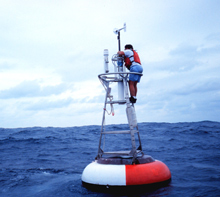
Personnel off the NOAA ship Ronald H. Brown maintaining Atlas TOGA-TAO buoys on the equatorial El Niño array. These buoys are instrumented to measure ocean temperature at varying depths and give forewarning of El Niño or La Niña events. Click image for larger view.
In order to develop a seasonal to interannual climate prediction, NOAA scientists must properly characterize or describe the ocean component of ocean-atmosphere forecast models. This characterization of the ocean is achieved by incorporating various observations (both in situ and satellite based) into the model.
The TAO-TRITON array currently provides the temperature observations needed to support these models. Plans include upgrading the observing system’s capabilities to provide additional salinity measurements that will enhance NOAA’s seasonal to interannual climate forecasting capabilities.
Carbon Dioxide and Climate
For the past 40 years, NOAA has documented rising concentrations of carbon dioxide in the atmosphere and, more recently, the oceans. Increased carbon dioxide in the atmosphere can act like a global blanket, trapping heat at the surface of the Earth and in the lower atmosphere. Some impacts include melting of glaciers and permafrost thawing, rising sea levels, changes in rainfall and rain intensity, and changes to growing seasons. Increased carbon dioxide in the oceans can change seawater chemistry and may have significant impacts on the biology of the upper oceans.
The observations, associated research, and model-based projections of climate change enhance our understanding of how the Earth is responding to increasing levels of human-emitted carbon dioxide.
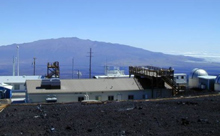
NOAA's Mauna Loa Observatory in Hawaii is one of the baseline observatories used to make careful and continual measurements of greenhouse gases.
Information on how changes in atmospheric carbon dioxide are impacting climate will be critical for policymakers as national and international trading options are considered for global carbon management. In order to control rising carbon dioxide and other pollutants in the atmosphere, governments around the world have considered the establishment of limits on the total amount of a pollutant that can be emitted. If one company were to exceed its limit, it could purchase a “credit” from another company that produced less than its approved limit. This would provide an economic incentive for reduced emissions and ensure that the total allowable limit is not exceeded.
If implementing an exchange program, nations will rely on scientific studies such as those by NOAA to determine what pollutant limits are needed in order to curb negative environmental impacts.
A National Approach
In 2002, the Climate Change Science Program (CCSP) was formed as a collaborative interagency program. Thirteen federal agencies, including NOAA, participate in the CCSP, which is designed to improve the government-wide management of climate science and climate-related technology development. CCSP coordinates and directs U.S. research efforts in the areas of climate and global change at decadal to centennial time scales to:
- reduce significant uncertainties in climate science;
- improve global observing systems;
- develop science-based information resources to support policymaking and resource management; and
- communicate findings broadly among the international scientific and user communities.
The scientific community is working to move modeling efforts beyond the physical climate system to encompass biogeochemical cycles and ecosystems and become comprehensive “Earth system” models. This approach will give NOAA the capability to integrate theory, observations, and modeling to tackle key unknowns in climate change science. These unknowns include the impact of climate change on corals, fisheries, and other ocean ecosystems; the consequences of a rapidly warming Artic; long-term projections of seasonal hurricane activity, flooding, and drought; and the potential for abrupt climate change.
NOAA and its CCSP partners are targeting these, and other, new challenges to provide policymakers with the best scientific information on climate change and its impacts.
Conclusion

NOAA's research laboratories, joint institutes, and programs work to meet the needs for climate information. These activities provide information that describes and explains climate and its impacts on natural systems and human activities, and climate prediction products and services for use by decision-makers and the general public.
Recent history has taught us that climate research has important socioeconomic implications. Climate research has branched out into several related areas, such as public policy and economic development, and NOAA has achieved major advances in climate research to better understand the behavior of the global climate system.
In recent years, however, NOAA has begun to face a new issue – the “societal relevance” of climate. We are now at an impasse where scientists are challenged with explaining very complex and technical, yet important, issues to the public. NOAA will need to continue to provide adaptive programs, projects, and partnerships to address this growing need.
Contributed by Dondi Ojeda, NOAA’s Office of Oceanic and Atmospheric Research
